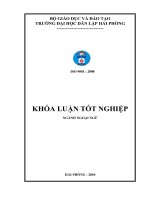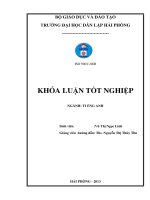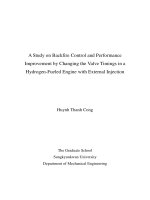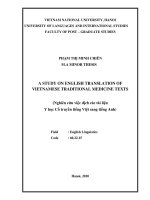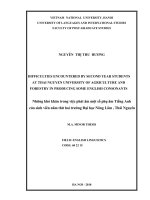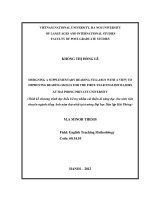A RESEARCH ON ENGLISH INVERSION AND DIFFICULTIES ENCOUNTERED BY ENGLISH MAJORS OF HAI PHONG PRIVATE UNIVERSITY
Bạn đang xem bản rút gọn của tài liệu. Xem và tải ngay bản đầy đủ của tài liệu tại đây (386.47 KB, 63 trang )
BỘ GIÁO DỤC VÀ ĐÀO TẠO
TRƯỜNG ĐẠI HỌC DÂN LẬP HẢI PHỊNG
-------------------------------
ISO 9001 : 2008
KHĨA LUẬN TỐT NGHIỆP
NGÀNH NGOẠI NGỮ
HẢI PHÒNG - 2010
HAIPHONG PRIVATE UNIVESITY
FOREIGN LANGUAGES DEPARTMENT
-----------------------------------
GRADUATION PAFER
A RESEARCH ON ENGLISH INVERSION AND
DIFFICULTIES ENCOUNTERED BY ENGLISH
MAJORS OF HAI PHONG PRIVATE UNIVERSITY
By:
TRAN THI HONG HANH
Class:
NA1004
Supervisor:
CHU THI MINH HANG, M.A
HAI PHONG - 2010
BỘ GIÁO DỤC VÀ ĐÀO TẠO
TRƯỜNG ĐẠI HỌC DÂN LẬP HẢI PHÒNG
--------------------------------------
Nhiệm vụ đề tài tốt nghiệp
Sinh viên: .........................................................Mã số:..........................
Lớp:............................Ngành:................................................................
Tên đề tài: .............................................................................................
...........................................................................................
Nhiệm vụ đề tài
1. Nội dung và các yêu cầu cần giải quyết trong nhiệm vụ đề tài tốt
nghiệp
(về lý luận, thực tiễn, các số liệu cần tính tốn và các bản vẽ).
……………………………………………………………………………..
……………………………………………………………………………..
……………………………………………………………………………..
……………………………………………………………………………..
……………………………………………………………………………..
……………………………………………………………………………..
……………………………………………………………………………..
……………………………………………………………………………..
2. Các số liệu cần thiết để thiết kế, tính tốn.
……………………………………………………………………………..
……………………………………………………………………………..
……………………………………………………………………………..
……………………………………………………………………………..
……………………………………………………………………………..
……………………………………………………………………………..
……………………………………………………………………………..
……………………………………………………………………………..
……………………………………………………………………………..
3. Địa điểm thực tập tốt nghiệp.
……………………………………………………………………………..
……………………………………………………………………………..
……………………………………………………………………………..
CÁN BỘ HƯỚNG DẪN ĐỀ TÀI
Người hướng dẫn thứ nhất:
Họ và tên:.............................................................................................
Học hàm, học vị:...................................................................................
Cơ quan công tác:.................................................................................
Nội dung hướng dẫn:............................................................................
Người hướng dẫn thứ hai:
Họ và tên:.............................................................................................
Học hàm, học vị:...................................................................................
Cơ quan công tác:.................................................................................
Nội dung hướng dẫn:............................................................................
Đề tài tốt nghiệp được giao ngày 12 tháng 04 năm 2010
Yêu cầu phải hoàn thành xong trước ngày 10 tháng 07 năm 2010
Đã nhận nhiệm vụ ĐTTN
Sinh viên
Đã giao nhiệm vụ ĐTTN
Người hướng dẫn
Hải Phòng, ngày tháng năm 2010
HIỆU TRƯỞNG
GS.TS.NGƯT Trần Hữu Nghị
PHẦN NHẬN XÉT TÓM TẮT CỦA CÁN BỘ HƯỚNG DẪN
1. Tinh thần thái độ của sinh viên trong quá trình làm đề tài tốt
nghiệp:
……………………………………………………………………………..
……………………………………………………………………………..
……………………………………………………………………………..
……………………………………………………………………………..
……………………………………………………………………………..
……………………………………………………………………………..
……………………………………………………………………………..
……………………………………………………………………………..
2. Đánh giá chất lượng của khóa luận (so với nội dung yêu cầu đã đề ra
trong nhiệm vụ Đ.T. T.N trên các mặt lý luận, thực tiễn, tính tốn số
liệu…):
……………………………………………………………………………..
……………………………………………………………………………..
……………………………………………………………………………..
……………………………………………………………………………..
……………………………………………………………………………..
……………………………………………………………………………..
……………………………………………………………………………..
……………………………………………………………………………..
……………………………………………………………………………..
3. Cho điểm của cán bộ hướng dẫn (ghi bằng cả số và chữ):
……………………………………………………………………………..
……………………………………………………………………………..
……………………………………………………………………………..
Hải Phòng, ngày ... tháng … năm 2010
Cán bộ hướng dẫn
(họ tên và chữ ký)
NHẬN XÉT ĐÁNH GIÁ
CỦA NGƯỜI CHẤM PHẢN BIỆN ĐỀ TÀI TỐT NGHIỆP
1. Đánh giá chất lượng đề tài tốt nghiệp về các mặt thu thập và phân tích tài
liệu, số liệu ban đầu, giá trị lí luận và thực tiễn của đề tài.
2. Cho điểm của người chấm phản biện :
(Điểm ghi bằng số và chữ)
Ngày.......... tháng......... năm 2010
Người chấm phản biện
ACKNOWLEGEMENTS
The graduation paper named “A research on English inversion and
difficulties encountered by English majors of Hai Phong private university ”
is the biggest scientific research for me during the last four years. In order to
finish it, besides my own efforts, I have a lot of help, guidance and
encouragement from my teachers, my family and my friends.
First, I wish to express all of my in – depth gratitude to my supervisor
Miss Chu Thi Minh Hang, M.A, the lecture of Hai Phong private university
for her valuable instructions and suggestions, careful corrections during the
development of my graduation paper.
Second, I would like show my thanks to Mrs. Tran Thi Ngoc Lien – the
dean of the foreign language department of Hai Phong Private University for
her help and encouragement.
My thanks also are sent to all the teachers of Hai Phong Private University
who have taught me with all their heart in unforgetable four years. They have
directly or indirectly contributed to the completion of this research.
Last but not least, I would also like to give my thanks to friends for their
constructive opinions so that I could finish this paper in time.
Hai Phong, 2010
Tran Thi Hong Hanh
TABLE OF CONTENTS
ACKNOWLEDGEMENTS
SYMBOLS AND ABBREVIATIONS
PART ONE:
INTRODUCTION
1. Rationale
2. Aims of the study
3. Methods of the study
4. Scope of the study
5. Design of the study
PART TWO:
DEVELOPMENT
CHAPTER I: THEORETICAL BACKGROUND
1. Inversion
1.1. The word – orders in English
1.2. Definition of Inversion
1.3. Operators
1.4. Communicative classification of sentence types
2. Summary of chapter one
CHAPTER II: DIFFERENT TYPES OF INVERSION AND
ITS EQUIVALENTS IN VIETNAMESE
1. Subject – verb inversion
1.1. Inversion with the initial here
1.1.1. Here plus be
1.1.2. Here plus other verbs
1.2. Inversion with the initial there
1.2.1. There plus be
1.2.2. There plus other verb
1.3. Inversion in reported speech
1.4. Inversion in formulae
1.5. Inversion with initial adverbials (of place)
1.5.1. Initial adverbials plus be
1.5.2. Initial adverbials plus verbs other than lexical be
2. Subject – operator inversion
2.1. Inversion in question
2.1.1. Inversion in Yes – No questions
2.1.2. Inversion in wh – questions
2.1.3. Inversion in alternative questions
2.2. Inversion in command with question tags
2.3. Inversion in exclamation
2.4. Inversion in statements
2.4.1. Inversion in sentence with if
2.4.2. Inversion after as
2.4.3. Inversion after neither, nor
2.4.4. Inversion after so
2.4.5. Inversion after adverbials with initial only
2.4.6. Inversion after negative adverbial
2.4.6.1. Inversion after seldom, rarely and never
2.4.6.2. Inversion after hardly, scarcely and no sooner
2.4.6.3. Inversion after adverbials containing the word no
CHAPTER THREE:
SOME DIFFICULTIES POSSIBLY ENCOUNTERED BY ENGLISH
MAJORS OF HAI PHONG PRIVATE UNIVERSITY WHEN USING
INVERSION AND SUGGESTED SOLUTIONS
1. Some difficulties possibly encountered by English majors of Hai Phong
private university when using inversion
1.1. Forming questions using Subject – operator inversion
1.2. Inversion structure
1.3. Understanding of inversion structure in formulate, exclamations and
conditional sentences
1.4. Misinterpretation in translating inversion from English in to Vietnamese
2. Some suggested solutions to overcome the difficulties
PART THREE:
REFERENCES
APPENDIX
CONCLUSION
SYMBOLS AND ABBREVIATIONS
A
Averbial
A.N
Negative adverbial
Aonly
Adverbial beginning with only
Aplace
Adverbial of place
Be
Be as verb
C
Complement
Op
Operator
Q-element
Clause element containing the Q- word
Q-word
Interrogative word
S
Subject
S1
The subject in the first clause
S2
The subject in the second clause
E.g
For example
Square brackets [ ] enclosing a number indicate the number of the
example used.
PART ONE
INTRODUCTION
1. Rationale
English is considered to be an international language used in many
fields such as economy, politics, science, technology, etc. It is widely
recognized as the key language in the intergrating process into the world.
Being aware of the important of English, Vietnamese learners try to
master English. A lot of Vietnamese people are learning English so as to work
with foreign learners more effectively. In recent years, the language has
become a compulsory subject in schools, colleges and universities in Viet
Nam. More and more English language teaching centres are opened to satisfy
the need of learners. And it is quite right to say that many of young learners
are interested in learning English.
To have a good command of English, Vietnamese students in general
and the first year English majors of Hai Phong Private University in particular
have a lot of difficulties in using English grammar properly, of which using
Inversion is one essential part. Inversion is phenomenon in which either a
verb or an operator stands before subject. It is device used to reduce the
length of the sentence and to emphasize the important factor theme in the
sentence. Inversion is governed much by the sentence structure. So in my
graduation paper, I study “English Inversion” with the hope that this can help
English major students at Hai Phong Private University learn English much
better.
That is the reason why I decided to choose the research with the title
“English inversion and difficulties encountered by English majors of Hai
Phong Private University”.
2. Aims of the study
This study is conducted to help English majors of Hai Phong private
university understand inversion more clearly. Further more it is hoped that
students learn how to use inversion phenomenon . To summarize the above,
my study is aimed at:
- Providing the theoretical background about English inversion
- Analyzing the types of inversion and its equivalents in Vietnamese
- Some difficulties possibly encountered by English majors of Hai Phong
private university when using inversion and suggested solutions
3. Methods of the study
To complete this graduation, the following steps are implemented:
- Collected references and books related to English grammar are analyzed in
details to form the theoretical background this paper.
- The available theory concerning to inversion is studied and followed in my
study paper.
- Discussing with asking help from teachers, friends and particularly whose
useful guidance, advice and correction have been actually crucial to the
completion of this study.
- Ideas of some possible difficulties are got from my understanding the
English learning and teaching and English major students in Hai Phong
private university as well as my gained experiences in the training course
4. Scope of the study
English grammar is various. In this study, I pay attention not only to
inversion in sentences but also to that in discourse. Inversion is a key matter
to be used to a great extent not only by speakers but also by writers. It works
mainly within the sentence, so the sentence structure is very important.
This study is carried out carefully and deeply as I hope it can reflect and
cover some common phenomena of inversion in English. In spite of this fact,
due to my lack of time, experience and knowledge, this study can not fail to
have mistakes. Therefore, your criticisms are very useful and important.
I hope that this study is good reference material for English major students
who wish to be better at English grammar.
5. Design of study
This study consists of three parts:
Part I: The introduction presents the rationale, aims, scope, methods
and the design of the study
Part II: The development is divided into three chapters:
The first chapter is the theoretical background which provides
readers the basic definitions of inversion and their relationship
with one another
The second chapter focuses on different kinds of inversion in
English and its equivalents in Vietnamese
The third chapter is about some difficulties possibly encountered
by English majors of Hai Phong private university when using
inversion and suggested solutions
Part III: is the conclusion which summarized all the presented
information
PART TWO
DEVELOPMENT
CHAPTER ONE: THEORETICAL BACKGROUND
1. Inversion
1.1. The word- orders in English
The English word – orders are also very important. In the scope of word
and especially in noun phrase, words with different positions will have
different meanings
[1]
The dancing girl
[2]
The visible stars
≠
≠
The girl dancing
The stars visible
In the scope of sentence, if positions of elements change the meanings of
sentence will change
[3]
The boy I like
≠
I like the boy
[4]
Tom comes here
≠
Here comes Tom
In a compound sentence with the change of sentence positions the
logical – meaningful relationship of two sentences will also change
[5]
Peter gets up at 6 a.m and has a shower (a)
Peter has a shower and gets up at 6 a.m
(b)
Reading two sentences above, we see that they are right in syntax but in
example (b) we can not accept its meaning because it is logical.
If we do not analyze the order of actions in example [5] we can list some
others as follows:
[6]
Among these girls, who likes you?
(c)
Among these girls, who do you like? (d)
Changing the word – order in example (c) we will have another sentence
(d) with quite different meaning but it is still correct in logic and semantics.
1.2 Definition of inversion
Each grammatical phenomenon has its own feature and its own function
to make sentences. To distinguish a grammatical phenomenon from other,
many linguists pay attention to its definition.
Through the definition, we can understand its function in language.
Different linguists have their own definitions of inversion and each definition
reflects different functions of inversion. Here are some definitions of
inversion found in English grammar books which have been popularly
recently.
Inversion means putting the verb before the subject. This happens in
question and in a number of other cases.
(Swan, 1980: 287)
Inversion is a phenomenon, which is associated with the thematic
fronting of an element. There are two types of inversion: Subject –
verb inversion and subject – operator inversion.
(Quirk.R, 1973: 412- 413)
Inversion is a rearrangement of the subject and verb or operator
from their normal order in statements
(Fagleson, 1983:61)
The above – mentioned definitions, to some extend we can understand
the inversion structures. According to Swan (1980) inversion is common in
ordinary spoken English only in questions and after “here, there, neither,
nor” and “so” other use of inversion are found mainly in written English or in
a very formal style of speaking. The use of inversion is regarded as standard
in question. Its purpose is to alter emphasis within the sentence. However it
can be seen that inversion sometimes can cause a difference in the meaning of
the sentence as a whole.
For example:
[7]
Tom is here. (1)
means he is in this room / building / town etc… But
(THM, 1985:54)
[8]
Here is Tom. (2)
(THM, 1985:54)
Implies that he has just appeared or that we have just found him.
Through these above definitions, we can know the various functions of
inversion. So, the basic of inversion is the word – order in the sentence
mentioned above.
In this study, Quirk.R (1973)’s definition is adopted as the main one in
my study. However, wherever suitable, I also draw on others’ concepts to
build up my study
1.3. Operators
Operator is the term applied to the first auxiliary verb of a verb phrase
which is a class of verbs phrase showing tense, aspect, voice and mood.
E.g:
does, is doing, did, etc
Has done, had done, would have done, would do.
In inversion, operator plays an important part to form a question. In
question operator is put before the subject.
[9]
Will
she ask any question?
Is
she asked any question?
Is
she asking any question?
Has
she asked any question?
Has she been asking any question?
Will she has been asked any question?
Wh – questions are formed by the Q-element which comes first in the
sentence. Then there come the operator and the subject except when the Qelement is subject.
[10]
Where did you find your key?
(EG, 1999:320)
[11]
Who teaches English?
(EG, 1999:321)
In negative statements, “not” is always placed after the operator:
[12]
John did not/ didn’t search the room.
(QUR, 1973:24)
[13]
I will not have retired by the year 2012.
(ALG, 1988:181)
The operator can be said to be a part of a verb phrase if that verb
phrase consist of one or more auxiliaries. When a verb phrase does not
contain any auxiliaries, it does not contain the word that can act as operator
for the purpose of forming questions and negative sentences with not. In such
case do is introduced when an operator is required.
[14]
It rained steadily all day.
Did it rain steadily all day?
(QUR, 1973:12)
In terms of lexical verbs BE and HAVE (sometimes in BrE). DARE and
NEED (are rarer in AmE than in BrE) can act like operators even when they
are verb phrase.
So the term operator is also used for them in such cases as the
following:
[15]
Was he waiting?
(THM, 1985:110)
[16]
Has he (got) to go?
(THM, 1985:110)
[17]
Dare you do it?
(ALG, 1988:236)
[18]
Need you leave so soon?
(ALG, 1988:229)
According to Quirk.R (1973), apart from the questions and the negatives,
there are a number of other constructions which require the use of an operator
In emphatic sentences:
[19]
You do look a wreck
(QUR, 1973:427)
In tag questions:
[20]
Joan recognized you, didn’t she?
(QUR, 1973:194)
Proforms
[21]
John can driver a car
I think Bob can
(QUR, 1973: 296)
In statements with inversion
[22]
Not until he got home did he realize that he had got lost it
(THM, 1985:63)
As mentioned above, the rearrangement of the subject and verb or
operator from their normal orders in statements is called inversion. So the
operator performs an important syntactic function. It is normally the first
auxiliary of the verb and when it operates, it is isolated from the rest of the
predicate despite how complex the predicator is Quirk.R states that the part of
the predicate distinguised from the operator is called predication.
1.4. Communicative classification of sentence types
According to Quirk.R (1973:191) simple sentences may be devided in to
four major syntactic classes whose use correlatives with different
communicative function:
1. Statements are sentences in which the subject is always present and general
precedes the verb:
[23]
John will speak to the boss today
(Quirk.R, 1973:191)
2. Questions are sentences marked by one or more of these three criteria:
a) The placing of the operator in front of subject:
[24]
Will John speak to the boss today?
(Quirk.R, 1973:191)
b) The initial positioning of an interrogative or Who-element
[25]
Who will you speak to?
(Quirk.R, 1973:191)
c) Rising intonation:
[26]
You will speak to the boss?
(Quirk.R, 1973:191)
3. Commands are sentences which normally have no overt grammatical
subject and whose verb is in the imperative
[27]
Speak to the boss today
(Quirk.R, 1973:191)
4. Exclamations are sentences which have an initial phrase introduced by
what or how, without inversion of subject and operator
[28]
What a noise they are making
(Quirk.R, 1973:191)
[29]
How beutifully you sing
(SWM, 1980:194)
Quirk.R states that, in English apart from the major classes of sentences,
there are the formulae in the sense that although they may have the
appearance of belonging to once of the major classes, they do not share the
features that are common to members of those classes.
According to Quirk.R, there are two types of inversion in English:
Subject – verb inversion and Subject – operator inversion.
In the next chapter, these types of inversion are going to be classified and
described in a detailed way.
2. Summary of Chapter I
In conclusion, I have examined all the basic notions of inversion. In many
authors’ notion, inversion is a special phenomenon. It aims is to express
fronting element and its structure differs from normal sentences. To study
inversion phenomenon we need to understand the word – orders in English,
the definition of inversion, operators, sentence types in communicative
function, all of which are taken into consideration in this chapter. The section
has ended chapter one. Let us go to chapter two where inversion is studied in
a detailed way.
CHAPTER TWO
DIFFERENT TYPES OF INVERSION AND ITS
EQUIVALENTS IN VIETNAMESE
As introduced in chapter one, there are two main types of inversion in English
+ Subject – verb inversion
+ Subject – verb operator
In this chapter, these types of inversion will be classified and compared with
Vietnamese equivalent sentences. Each of these types will be dealt with in
turn: Subject – verb inversion in (1) and Subject – verb operator in (2)
1. Subject – verb inversion
1.1. Inversion with the initial “here”
1.1.1. “Here” plus Be
“Here” followed by the simple present tense of the verb “be” and a noun
phrase subject is commonly used when the speakers want to draw the
attention to the presence of some one or some thing, or when they are offering
things or identifying locations (the subject can be singular or plural).
[30]
Here is Tom
Tom đây rồi
(THM, 1985:54)
[31]
Here is a cup of tea for you
Tách trà của anh đây
(ALG, 1988:143)
[32]
Here are your letters
Mấy lá thư của anh đây.
(BHV, undated)
“Here” used in the above examples carries more stress than “here”
placed after the verb. There is also usually a difference in meaning between
these two cases
While “Tom is here” means he is in this room/ building/ town, etc. “Here
is Tom” implies that he has just appeared or that we have just found him.
It can be said that the use of subject – verb inversion with intensive “be”
as the verb after here is equivalent to the use of “đây/ đây rồi” after the
subject in Vietnamese.
English
Vietnamese
Here + be + S
S + đây/ đây rồi
Besides, the inversion of a subject and intensive “Be” after the adverbial
“Here” can also be found in another case
[33] Here is the news. A diplomat was kidnapped last night in London….
(radio announcement)
(QUR, 1973:303)
According to Quirk.R (1973), here in the above example functions as a
sentence cataphoric reference signal because it points forward in the
discourse. This inversion is equivalent to inversion in Vietnamese languages
as shown in the following structure:
English
Vietnamese
Here + be + S
Đây + là + S
Noticebly, subject – verb inversion does not occur in the sentence if the
subject is a pronoun
[34]
Here you are
(ALG, 1988:143)
[35]
Where are my keys?
Oh, here they are
(EAJ, 1994:57)
1.1.2. “Here” plus other verbs
Subject – verb inversion can be found after here on the condition that the
subject is a noun phrase. This is common with verbs of motion such as come
and go and progressive is not used
[36]
Here comes a taxi!
Taxi đến rồi
(ALG, 1988:143)
This initial here carries more stress than here placed after the verb. There
is usually a different in meaning between Tom comes here and Here comes
Tom. Whereas the former means that it is habit to come to this place, the
latter implies that he has just arriving or he has just arrived.
(THM, 1985:54)
It is clear seen that this inversion structure is used when the speaker
shows that he has just seen somebody or something. In Vietnamese, the use of
Subject – verb inversion with other verbs after “here” is equivalent to the use
of “đây rồi” after verbs of motion and the subject.
Through that, we can see how this structure is realized in Vietnamese
language:
English
Vietnamese
Here + Vmotion+ S
S + Vmotion + đây rồi
And once again, inversion does not take place in a sentence with a
personal pronoun as subject:
[37]
Here it comes
Nó đến đây rồi
(ALG, 1988:143)
1.2. Inversion with the initial “There”
1.2.1. “There” plus Be
Like here, there also followed by the simple present tense of the verb be
and a noun phrase, subject is commonly used when people want to draw
attention the presence of somebody or some thing when they are used to
identify locations
[38]
There is your brother
Anh trai của bạn kia kìa
(QUR, 1973:228)
[39]
There is Anna
Anna kìa
(THM, 1985:54)
There is the above – example is stressed and pronounced / ðe∂(r)/ with
the meaning over there. It is different from the unstressed word / ð∂(r)/ in
existential sentences
[40]
There was a furniture van outside the house
(EAJ, 1994:58)
The use of Subject – verb inversion with verb after there is equivalent to
the use of kìa/ kia kìa after the subject in Vietnamese.
English
Vietnamese
There + be + S
S + kìa/ kia kìa
1.2.2. “There” plus other verbs
Once more function of there similar to here is that it can function as the
initial adverbial in subject – verb inversion structure for directing people’s
attention to somebody or some thing in the situation. The verb is usually a
simple present verb of motion and the subject is realized by a noun phrase
[41]
There goes the last train
Chuyến tàu cuối cùng đến kìa
(ALG, 1988:143)
By comparison, Vietnamese speaker make use of the word kìa after the
subject of the verb of motion
